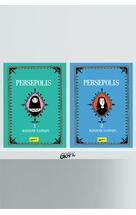The artistry and the revelations of Persepolis make it a required read
The thing that will astonish you most about Marjane Satrapi's "Persepolis" is not that it is a graphic work published by a major trade house (Pantheon, an imprint of Random House). Nor will it be the luxurious quality of the production - a hardcover with a die-cut dust-jacket that lets a character peek through from the cover. Instead, "Persepolis" (153 pp.; $17.95) will zap you with its story. A memoir of growing up as a girl in revolutionary Iran, "Persepolis" provides a unique glimpse into a nearly unknown and unreachable way of life. It has the strange quality of a note in a bottle written by a shipwrecked islander. That Satrapi chose to tell her remarkable story as a gorgeous comicbook makes "Persepolis" totally unique and indispensable.
Marjane Satrapi spent the first fourteen years of her life in Tehran, as the daughter of well-educated, middle-class, left-wing parents. At the beginning of "Persepolis," she recalls her early obsession with becoming God's new Prophet. Practically personifying her country's sacred-secular struggle, she would decree that their maid could eat at the table with them and that her father's Cadillac would be banned. While her parents demonstrated against the Shah, Satrapi would march around the backyard with her friends, pretending to be Che Guevara. Like Satrapi, I was nine when the Shah fell in 1979. That the so-called "Islamic Revolution" began as a populist revolt that included secular, left-wing socialists is just one of this book's many surprises for someone like myself . The celebrations of the revolution take on a bittersweetness when imprisoned members of Satrapi's family are freed and return with tales of torture and murder.
Then things start to go badly.
Citiţi articolul în întregime aici.


